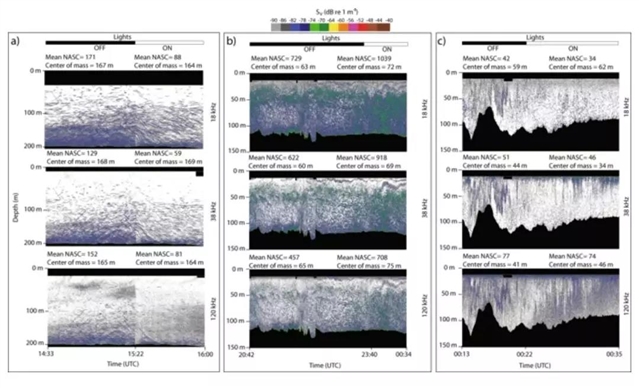人造光在极夜期间干扰海洋生物 |《通讯-生物学》
论文标题:Artificial light during the polar night disrupts Arctic fish and zooplankton behaviour down to 200 m depth
作者:Jørgen Berge, Maxime Geoffroy et.al
发表时间:2020/03/05
数字识别码:10.1038/s42003-020-0807-6
微信链接:点击此处阅读微信文章
根据本周《通讯-生物学》发表的一篇论文Artificial light during the polar night disrupts Arctic fish and zooplankton behaviour down to 200 m depth,北极海底200米处的海洋生物会受到船只上人造光的干扰。这项发现意味着在极夜期间,人造光会影响种群调查,进而对可持续管理工作产生影响。

研究区域和三个研究地点的水文特征。
图片来源:Berge, J., Geoffroy, M., Daase, M.等
鱼类和浮游动物依靠自然光调整自身行为和迁徙模式。人造光会干扰这些动物分辨方向,破坏生态系统,进而影响研究人员准确观察海洋生物的能力。但是,人造光对于海洋生物的影响仍没有得到充分研究,在北极长达6个月的极夜期间尤其如此。极夜期间,鱼类和浮游动物只能依靠夜间光线发生的微弱的自然变化。挪威特罗姆瑟大学—挪威北极圈大学的Jørgen Berge等人在北极的三个地点,测量了鱼类和浮游动物在极夜期间如何响应来自船只的人造光。他们发现当船上的灯打开时,这些动物几乎会立即(5秒内)改变行为。海底200米的动物的游动行为和垂直位置都发生了改变。作者发现,人造光对于动物行为的影响在三处地点之间存在差异,影响最明显的是最北边的一处,那里夜晚最暗。

当灯熄灭和开启时,EK60回声仪在18 kHz、38 kHz和120 kHz的回波图。
图片来源:Berge, J., Geoffroy, M., Daase, M. 等
作者总结认为,未来在极夜期间做科考和种群评估时,应该将上述发现考虑在内。
摘要:For organisms that remain active in one of the last undisturbed and pristine dark environments on the planet—the Arctic Polar Night—the moon, stars and aurora borealis may provide important cues to guide distribution and behaviours, including predator-prey interactions. With a changing climate and increased human activities in the Arctic, such natural light sources will in many places be masked by the much stronger illumination from artificial light. Here we show that normal working-light from a ship may disrupt fish and zooplankton behaviour down to at least 200 m depth across an area of >0.125 km2 around the ship. Both the quantitative and qualitative nature of the disturbance differed between the examined regions. We conclude that biological surveys in the dark from illuminated ships may introduce biases on biological sampling, bioacoustic surveys, and possibly stock assessments of commercial and non-commercial species.
(来源:科学网)

